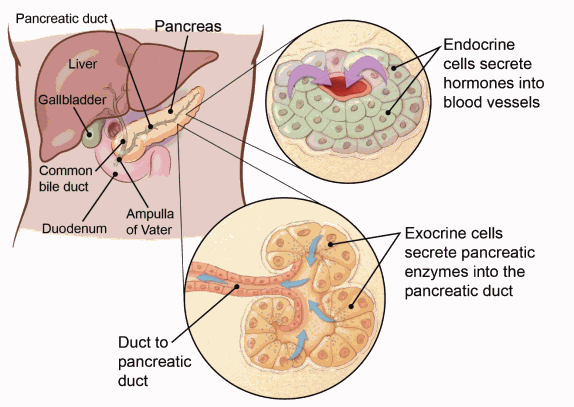What Is Pancreatic Cancer?
Pancreatic cancer is a type of cancer that starts in the pancreas. Pancreatic adenocarcinoma is the most common type of pancreatic cancer. Pancreatic neuroendocrine tumors (NETs) are a less common type and are discussed in Pancreatic Neuroendocrine Tumors.
Where pancreatic cancer starts
The pancreas
The pancreas is an organ that sits behind the stomach. It’s shaped like a fish with a wide head, a tapering body, and a narrow pointed tail. In adults it’s about 6 inches (15 centimeters) long and less than 2 inches (5 centimeters) wide.
- The head of the pancreas is on the right side of the abdomen (belly), behind where the stomach meets the duodenum (the first part of the small intestine).
- The body of the pancreas is behind the stomach.
- The tail of the pancreas is on the left side of the abdomen next to the spleen.

Pancreatic adenocarcinoma is the most common type of pancreatic cancer. It forms when exocrine cells in the pancreas start to grow out of control. Most of the pancreas is made up of exocrine cells, which form the exocrine glands and ducts. The exocrine glands make pancreatic enzymes (proteins that help you digest food) that are released into tiny tubes called ducts, which empty into the pancreatic duct The pancreatic duct merges with the common bile duct (the duct that carries bile from the liver) and empties into the duodenum (the first part of the small intestine) at the ampulla of Vater.
Endocrine cells make up a smaller percentage of the cells in the pancreas. These cells make hormones like insulin and glucagon, both of which help control blood sugar levels. Pancreatic neuroendocrine tumors start in the endocrine cells. See Pancreatic Neuroendocrine Tumor to learn more about this type.
If you are diagnosed with pancreatic cancer, it’s very important to know if it’s an endocrine cancer (see Pancreatic Neuroendocrine Tumor) or exocrine cancer (also known as adenocarcinoma, discussed here). They have distinct risk factors and causes, have different signs and symptoms, are diagnosed with different tests, are treated in different ways, and have different outlooks.
Types of pancreatic cancer
Exocrine cancers are by far the most common type of pancreas cancer.
Pancreatic adenocarcinoma: About 95% of cancers of the exocrine pancreas are adenocarcinomas. These cancers usually start in the ducts of the pancreas.
Less common types of exocrine cancer: Other, less common exocrine cancers include adenosquamous carcinomas, squamous cell carcinomas, signet ring cell carcinomas, acinar cell carcinomas, undifferentiated carcinomas, and undifferentiated carcinomas with giant cells.
Ampullary cancer (carcinoma of the ampulla of Vater): This cancer starts in the ampulla of Vater, which is where the bile duct and pancreatic duct come together and empty into the small intestine. Ampullary cancers aren’t technically pancreatic cancers, but they are included here because they are treated much the same.
Ampullary cancers often block the bile duct while they’re still small and have not spread far. This blockage causes bile to build up in the body, which leads to yellowing of the skin and eyes (jaundice). Because of this, these cancers are usually found earlier than most pancreatic cancers, and they usually have a better prognosis (outlook).
Benign and precancerous growths in the pancreas
Some growths in the pancreas are simply benign (not cancer), while others might become cancer over time if left untreated (known as precancers). Because people are getting imaging tests such as CT scans more often than in the past (for a number of reasons), these types of pancreatic growths are now being found more often.
Serous cystic neoplasms (SCNs) (also known as serous cystadenomas) are tumors that have sacs (cysts) filled with fluid. SCNs are almost always benign, and most don’t need to be surgically removed unless they grow large or cause symptoms.
Mucinous cystic pancreatic neoplasms (MCPNs) (also known as mucinous cystadenomas) are slow-growing tumors that have cysts filled with a jelly-like substance called mucin. These tumors almost always occur in women. While they are not cancer, some of them can progress to cancer over time if not treated, so these tumors are typically removed with surgery.
Intraductal papillary mucinous neoplasms (IPMNs) are cystic tumors that grow in the pancreatic ducts. Like MCPNs, these tumors make mucin, and over time they can become cancer if not treated. Some IPMNs can just be followed closely over time, but some might need to be removed with surgery if they have certain features, such as if they are in the main pancreatic duct.
Solid pseudopapillary neoplasms (SPNs) are rare, slow-growing tumors that typically develop in young women. Even though these tumors tend to grow slowly, they can sometimes spread to other parts of the body if left untreated. SPNs are best treated with surgery. The outlook for people with these tumors is usually very good.
- Written by
- References

The American Cancer Society medical and editorial content team
Our team is made up of doctors and oncology certified nurses with deep knowledge of cancer care as well as editors and translators with extensive experience in medical writing.
Mauro LA, Herman JM, Jaffee EM, Laheru DA. Chapter 81: Carcinoma of the pancreas. In: Niederhuber JE, Armitage JO, Dorshow JH, Kastan MB, Tepper JE, eds. Abeloff’s Clinical Oncology. 5th ed. Philadelphia, Pa. Elsevier: 2014.
Winter JM, Brody JR, Abrams RA, Lewis NL, Yeo CJ. Chapter 49: Cancer of the Pancreas. In: DeVita VT, Lawrence TS, Rosenberg SA, eds. DeVita, Hellman, and Rosenberg’s Cancer: Principles and Practice of Oncology. 10th ed. Philadelphia, Pa: Lippincott Williams & Wilkins; 2015.
Last Revised: February 5, 2024
American Cancer Society medical information is copyrighted material. For reprint requests, please see our Content Usage Policy.
American Cancer Society Emails
Sign up to stay up-to-date with news, valuable information, and ways to get involved with the American Cancer Society.


